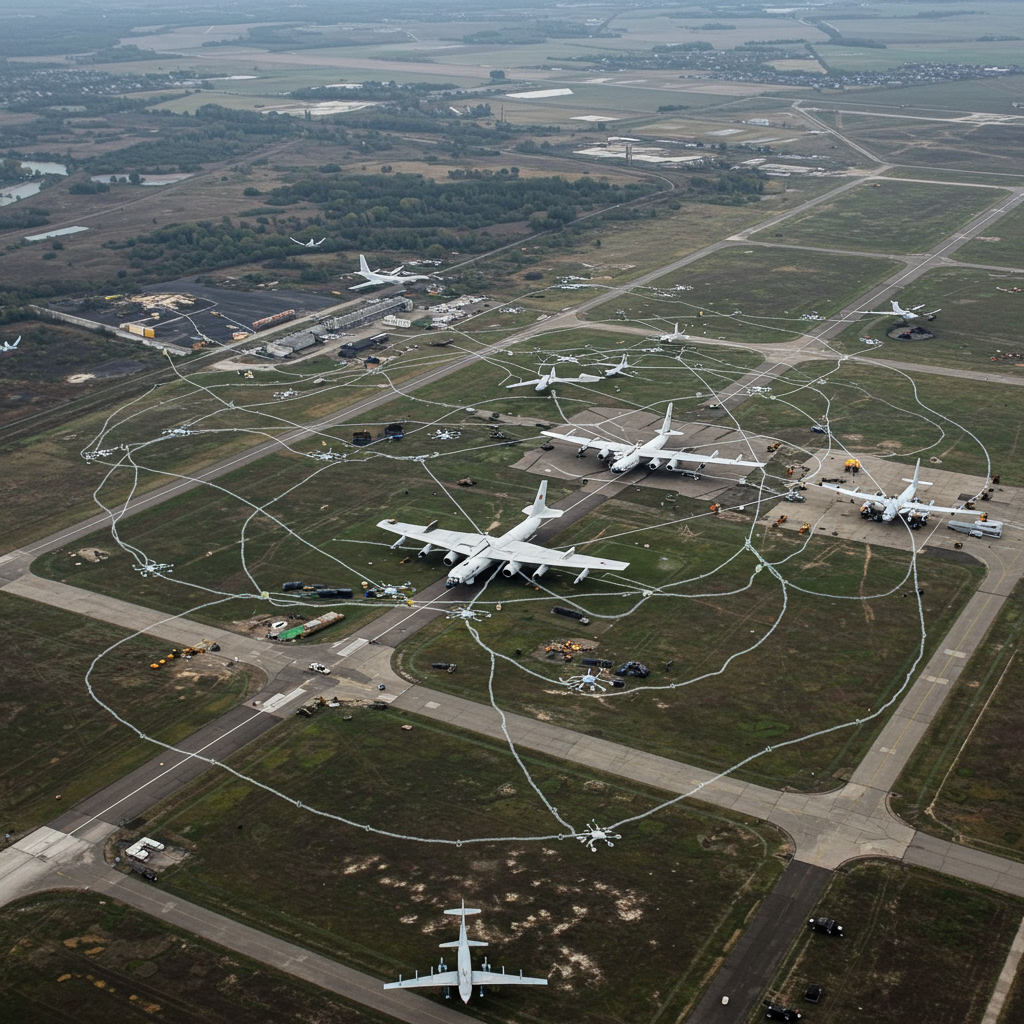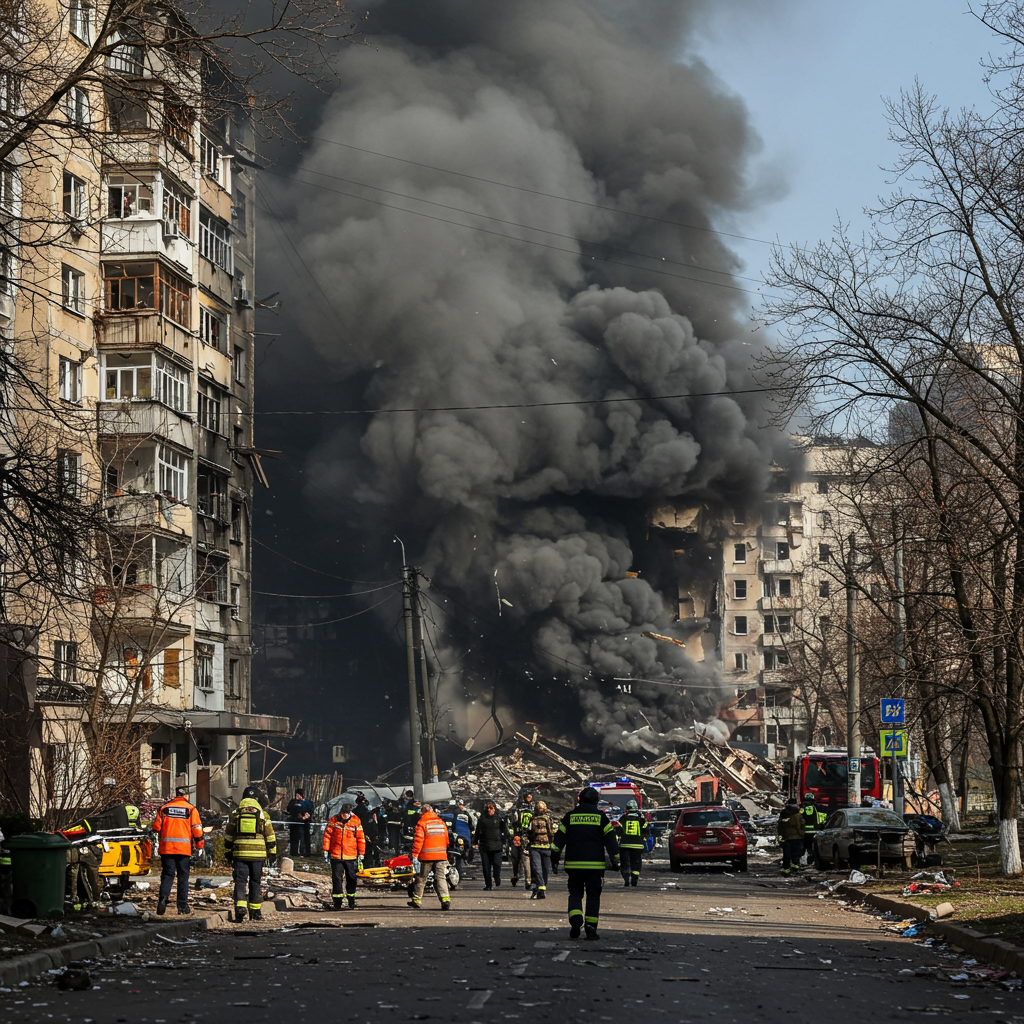In an operation described as an act of astonishing ingenuity, Ukraine successfully launched a broad, unprecedented drone attack on Russian air bases deep inside the country on June 1. Dubbed “Spider Web,” this daring operation, which targeted Russia’s nuclear-capable long-range bombers, was reportedly more than 18 months in the making and involved intense preparation.
The “Spider Web” Unfolds: Unprecedented Scale and Reach
The scale of the “Spider Web” attack was immense, with over 100, and specifically confirmed by President Zelensky as 117, Ukrainian drones striking targets across five Russian regions and multiple time zones. The reach extended from Murmansk above the Arctic Circle to the far eastern Amur region, covering distances of over 8,000km from Ukraine and more than 4,300km from the front lines – marking it as Ukraine’s longest-range operation to date.
The Russian Defence Ministry acknowledged attacks occurred in Murmansk, Irkutsk, Ivanovo, Ryazan, and Amur. While Moscow claimed attacks were repelled in some areas, they confirmed damage to aircraft in Murmansk and Irkutsk regions, stating several planes caught fire after drone launches from nearby areas. Verified video footage and radar satellite imagery later showed damaged aircraft at bases like Olenegorsk in Murmansk and Belaya in Irkutsk, including visual confirmation of strikes on Tu-95 bombers and satellite evidence suggesting at least four badly damaged or destroyed bombers at Belaya.
The Ingenious Smuggling Method
A crucial element of the “Spider Web’s” success lay in its highly unconventional delivery method. According to Ukrainian Security Service (SBU) head Vasyl Maliuk, the drones were not launched from Ukraine’s border but were instead smuggled into Russia concealed within wooden cabins mounted on the back of lorries.
These specially designed cabins featured remotely operated detachable roofs. The lorries were then reportedly driven to locations near the target airbases by drivers who were largely unaware of their clandestine cargo. Once in proximity, the roofs were opened, and the drones were launched. Online videos purportedly show drones emerging from these vehicles. Russian media reports corroborated elements of this story, with some lorry drivers describing receiving phone instructions on where to park and being stunned to see drones fly out, with some even attempting to stop them with rocks. President Zelensky added a remarkable detail, claiming the operational coordination “office” inside Russia was situated “right next to the FSB of Russia in one of their regions,” and that all involved operatives were safely withdrawn before the strikes.
The complexity and planning involved were significant, with Zelensky noting the operation took “one year, six months and nine days” to prepare under his direct supervision.
Targeting Russia’s Strategic Aviation
The primary targets of the “Spider Web” operation were Russia’s most valuable strategic aircraft: nuclear-capable long-range bombers such as the Tu-95, Tu-22M3, and Tu-160, as well as A-50 military spy planes. These aircraft are vital for Russia’s long-range missile strikes against Ukraine and for coordinating airspace control and interception.
SBU head Vasyl Maliuk stated that these military airfields and the aircraft that bomb Ukrainian cities were “absolutely legitimate targets” under the laws and customs of war. Ukraine claimed substantial losses for Russia, asserting 41 strategic bombers were hit and at least 13 were destroyed, significantly impacting Russia’s strategic cruise missile carrier fleet.
The targeted bombers, being out of production, are difficult or impossible for Russia to replace, making any damage or destruction a severe, potentially irreversible blow to their strategic capabilities. The A-50 spy planes are also scarce, with estimates suggesting Russia possesses only a handful, so any loss or damage is highly impactful. Ukraine estimated the total cost to Russia from the “Spider Web” operation at approximately $7 billion.
The Technology and Innovation
Dr. Steve Wright, a UK-based drone expert, identified the drones used as simple quadcopters capable of carrying relatively heavy payloads. He highlighted the “extraordinary” aspect of the operation as being the successful smuggling and remote launch/command of these drones so deep inside Russia. Control was likely maintained via satellite or internet links, potentially incorporating manual piloting to overcome localized Russian jamming efforts. Zelensky confirmed each of the 117 drones had its own pilot, suggesting sophisticated remote control capabilities. While Ukraine has not disclosed the origin of the drones, the country has developed significant domestic drone manufacturing capabilities during the conflict.
Retired Major-General Gus McLachlan praised Ukraine’s “innovation” and adaptability, noting the stark contrast between the low cost of FPV drones (estimated around $4,000 each) and the potentially billions of dollars worth of irreplaceable aircraft targeted. This operation demonstrated how relatively inexpensive, commercially adaptable technology could inflict significant damage on high-value military assets, representing a “powerful strike” delivered by “tiny, cheap drones.”
Reactions and Ramifications
Following the attack, Russian state media remained notably quiet, primarily quoting regional authorities and with the story reportedly disappearing from national bulletins by the following morning.
In contrast, Ukrainians celebrated the success of the operation, with some calling it “titanic.” President Zelensky underscored the historical significance, stating that while not all details could be revealed, these actions would “undoubtedly be in history books.” The attack occurred amidst ongoing diplomatic efforts, including discussions regarding potential peace talks.
The “Spider Web” operation stands as a testament to Ukrainian ingenuity and military innovation, successfully striking deep into Russian territory and demonstrating a remarkable capability to overcome significant logistical and technical challenges to target crucial Russian strategic assets.
References
- https://www.bbc.com/news/articles/cq69qnvj6nlo
- https://www.bbc.co.uk/news/articles/cq69qnvj6nlo
- https://www.bbc.com/news/articles/c1ld7ppre9vo
- https://www.abc.net.au/news/2025-06-02/ukraine-drone-attack-on-russian-air-bases-explained/105364708




